Download - Focal Point
Transcript
INSTALLATION & USER INSTRUCTIONS INSET DECORATIVE GAS FIRE MODELS COVERED BY THESE INSTRUCTIONS HANNINGTON TAPER GAS INSET TRAY GB IE Focal Point Fires plc. Christchurch, Dorset BH23 2BT Tel: 01202 499330 Fax: 01202 499326 www.focalpointfires.co.uk e : [email protected] MODEL SHOWN : HANNINGTON BRASS Questions or problems with your appliance? Don’t take it back to the store just give us a call on 01202 588601 we’re here to help lines open between 9am and 5pm, Monday to Friday IN THE UK ALWAYS USE A GAS SAFE REGISTERED ENGINEER TO INSTALL, REPAIR OR SERVICE THIS APPLIANCE Please note : Except where otherwise stated, all rights, including copyright in the text, images and layout of this booklet is owned by Focal Point Fires plc. You are not permitted to copy or adapt any of the content without the prior written permission of Focal Point Fires plc. All instructions must be handed to the user for safekeeping. 1 Revision E - 12/13 ' 2013 Focal Point Fires plc. I N S TA L L AT I O N Section 1.0 2.0 3.0 4.0 5.0 6.0 6.1 7.0 8.0 9.0 10.0 11.0 11.1 I N S T R U C T I O N S Contents Page No. Section Contents Important Notes 2 12.0 Spark Gap Appliance Data 3 12.1 Operating Pressure Installation Requirements 3 12.2 Flue Spillage Monitoring System Site Requirements 3 12.3 Testing For Spillage Ventilation 4 12.3 Briefing the Customer Unpacking the Appliance 4 13.0 Servicing Component Checklist 4 13.1 Cleaning the Ceramics Installing the Burner 4 13.2 Removing the Burner Fuel Bed Layout 5 13.3 Servicing the Burner Fire Front 5 13.4 Pilot Assembly Testing & Commissioning 5 13.5 Replacing the Batteries (Remote Control Models) Operating the fire (Manual Models) 5 14.0 Troubleshooting Guide Operating the fire (Remote Models) User Instructions 5 GB IE Page No. 6 6 6 6 6 6 6 7 8 8 8 8 1.0 IMPORTANT NOTES • This appliance is an Inset Decorative Fuel Effect appliance which provides radiant warmth utilising the latest type burner technology. • The fire is designed to suit various types of fireplaces and natural draught flues as detailed in this manual. • The appliance must be installed by a competent person in accordance with Gas Safety (Installation and Use) Regulations 1998. It is strongly recommended that a GAS SAFE registered engineer be used for this purpose. • Read all these instructions before commencing installation. • This appliance must be installed in accordance with the rules in force and used only in a sufficiently ventilated space. • The appliance is designed for installation on to a non-combustible hearth of at least 300mm depth. • This appliance is factory set for operation on the gas type, and at the pressure stated on the appliance data plate. • In the event of gas leakage from the appliance, the gas supply must be turned off at the nearest isolating valve. • The appliance must be installed in accordance with the following: • Failure to comply with the above could lead to prosecution and deem the manufacturer’s warranty invalid. • The appliance is designed to fit various types of situations as described in sections 3.0 and 4.0. • Manufacturers' Instructions. • The Building Regulations issued by the Department for Communities and Local Government, the Building Standards (Scotland) (Consolidation) Regulations issued by the Scottish Development Department. • Relevant British Standards insofar as the relevant areas are not covered by these instructions. • For Republic of Ireland, reference should be made to the current edition of IS813 (the relevant standards governing installation). • It should be noted that heaters create warm air currents. These currents move heat to wall surfaces next to the heater. Installing the heater next to vinyl or cloth wall coverings or operating the heater where impurities in the air (such as tobacco smoke, candle smoke etc.) exist, may cause the walls to become discoloured. • WARNING: The manufacturer of this appliance considers all surfaces as working surfaces with the exception of the control knob and ash pan door. • As with any gas fire, a fire guard complying with BS 8423 must be used in presence of pets, children, and the elderly or infirm. • Consult ALL instructions before installation and use of this appliance. • This appliance is intended for decorative purposes. • This appliance is free from any asbestos material. • Refractories and fuel bed are constructed from ceramic fibre. 2 ' 2011 Focal Point Fires plc. 2013 2.0 APPLIANCE DATA Model Sonora Destination Country Cat GB - IE I2H Natural gas Specifications Main burner injector Oxypilot Gas Control Gas Inlet Ignition Spark Gap Flue specification GB IE Operating Pressure (±2.0 mbar) G20 20 G25 G30 - - Max Energy Input (kW) G31 Gross - Min Energy Input (kW) Net 6.8 Gross 6.1 Net 3.5 3.15 Manual control models Remote control models Stereo size 76 Stereo size 81 SIT 9081 SIT 9081 Copreci 21400/342 Mertik Maxitrol GV30 series 8mm compression - Inlet restrictor elbow 8mm compression - Inlet restrictor elbow Piezo Spark Piezo Spark 3.5 - 4.5mm 3.5 - 4.5mm 225mm x 225mm (9in x 9in) brick or stone. 175mm (7in) minimum diameter lined brick or stone. 175mm (7in) minimum diameter twin wall flue conforming to BS 715. 3.0 INSTALLATION REQUIREMENTS This appliance MUST NOT be installed into a room containing a bath or shower, or where steam may be present. The fire has been designed to fit into a builders’ opening or fireplace conforming to BS 1251 (and meeting certain dimensional requirements), or a suitable flue box complying with the constructional requirements of BS 715. Either a ‘Replacement Chairbrick’ or a BS 1251 chairbrick should also be fitted into the builders’ opening. The flue box must be installed onto a suitable non-combustible insulating surface at least 12mm thick, covering the entire base are of the box. The flue must have an effective height of at least three meters, as measured from the hearth to the top of the flue. Any flue damper plates or restrictors should be removed and no other restriction fitted to the flue. Where removal is not practical, the restriction must be fixed in the fully open position. A natural draught flue system is required, and if previously used for solid fuel or oil burning, the flue and chimney must be swept prior to appliance installation. The flue must be checked before installation by using a smoke pellet or similar to ensure proper draw and that leakage is not evident at any joints. Repair and re-test as necessary before the appliance is installed.The flue must be connected to only one fireplace, and the flue must not vent more than one appliance (i.e. not shared with a gas back boiler). There must be no opening in the flue apart from the one that the appliance is installed into, and the one venting the gases into the air. A suitable terminal may be fitted, such as class GC1, as regulations allow. This appliance has been tested for use with circular flues of a minimum internal diameter of 175mm. The flue termination (cowl) must be of a type suitable for use with an inset Decorative Fuel Effect Fire BS5871 part 3 contains further details. 4.0 SITE REQUIREMENTS The fireplace opening should be inspected and repairs made where necessary. Any chair brick may be left in place. The opening WIDTH and HEIGHT dimensions should be between 405mm and 440mm wide, and 565mm to 575mm high. Opening DEPTH should be 220mm or greater. Opening DEPTHS include any plaster or infill panels which form part of the installation. This appliance requires a natural draught flue system which may be one of the following; • 225mm x 225mm (9in x 9in) brick or stone. • 175mm (7in) minimum diameter lined brick or stone. • 175mm (7in) minimum diameter twin wall flue conforming to BS 715. Any existing under grate draught device must be sealed off. The opening wall must be non-combustible. The appliance requires a hearth with non-combustible surface of at least 12mm thick. The top surface must be at least 50mm above the surrounding floor level, or be surrounded by a raised edge or fender 50mm high. ‘A’ ‘F’ ‘D’ ‘C’ ‘B’ ‘E’ Figure 1 A. Opening height: 565mm min/575 mm max. B. Opening width: 405mm min/440mm max. C. Mounting depth: 220mm D. Hearth must extend minimum of 150mm either side of the opening. E. Hearth must extend minimum of 300mm in front of the opening. F. Non-combustible hearth must be a minimum of 50mm in height, or be surrounded by a 50mm high fender. 3 ' 2013 Focal Point Fires plc. 4.0 SITE REQUIREMENTS - CONTINUED Any type of fire surround used with this appliance must be adequately sealed to the wall and floor. A combustible shelf may be fixed to the wall above the fire, providing that it complies with the dimensions given below. Maximum depth of shelf GB IE Minimum distance from finished hearth surface to underside of shelf 745mm 845mm 895mm 100mm 150mm 203mm A non-combustible shelf may be fitted to within 10mm of the top edge of the fireplace opening. Combustible materials, such as wood, may be fitted to within 100mm (4in) of either side of the fireplace opening , providing the forward projection does not exceed 100mm (4in). Any combustible side walls must be at least 500mm to the side of the radiant heat source. As with all heating appliances, any decorations, soft furnishings, and wall coverings (i.e. flock, blown vinyl and embossed paper) positioned too close to the appliance may discolour or scorch. 5.0 VENTILATION No purpose provided ventilation is normally required for this appliance. The requirements of other appliances operating in the same room or space must be taken into consideration when assessing ventilation. If spillage is detected when commissioning the appliance then amongst other problems there may be insufficient natural ventilation for the correct operation of the flue. This is potentially a greater problem should the property be of modern nature. If the appliance does not spill with windows open but does with windows closed, this proves that lack of ventilation is the problem, if not, it will be the flue at fault. Installation of an air brick in these circumstances may be the best solution. Any ventilation fitted must comply with BS 5871 part 2 and BS 5440 part 2. Ventilation located underneath or within the immediate vicinity (one metre) of the fire MUST NOT be used as it may adversely affect the performance of the O.D.S. system. Spillage detected during commissioning is almost always a result of poor flue performance, which cannot be corrected by any amount of ventilation. For Republic of Ireland ventilation may be required, see IS 813, ICP3, IS 327, and any other rules in force. 6.0 UNPACKING THE APPLIANCE Read all the instructions before continuing to unpack or install this appliance. Remove the box containing the firefront, and the bag containing the coals. Remove the cardboard packing pieces, and any bags containing other fittings or parts. Remove the burner unit from the remaining packaging. Check that the components supplied correlate with the checklist given in section 6.1. Please dispose of the packaging materials at your local recycling centre. 6.1 COMPONENT CHECKLIST QUANTITY 1 1 1 16 1 1 1 DESCRIPTION Burner tray assembly. Cast firefront with separate ashpan cover. Moulded ceramic fibre combustion matrix. Individual ceramic coals. Moulded ceramic front coal strip. Set of manufacturers instructions. Screw pack. 7.0 INSTALLING THE BURNER Note: Ensure that the gas supply is isolated before commencing installation of the appliance. Smoke test the flue to ensure proper draw and that there are no leaks present. Locate the gas supply point. This appliance is suitable for all gas connections, including those concealed behind the opening. Important Note: Check that the thermocouple connection nut into the rear of the valve is secure. Place the appliance into the shaped firebrick, ensuring it does not protrude forward of the fireplace opening. Mark the location of the front support of the tray. Remove the tray and drill the two marked holes with an appropriate masonry bit. Place wall plugs into the holes. Remove the front support from the appliance by unscrewing from the two front legs. Position the front foot in the over the holes and secure the front support using suitable screws into the prepared holes. Re-fit the tray into the shaped firebrick, and secure the front legs of the tray to the support. Using 8mm diameter pipe, connect the appliance to the gas supply point. The appliance must be fitted with rigid or semi-rigid pipe of 8mm external diameter. The appliance is factory fitted with an inlet restrictor elbow. Use a minimum length of 8mm pipe, less than 1.5m where possible, as a long run of pipe may cause an unacceptable drop in the supply pressure. 4 ' 2013 Focal Point Fires plc. 8.0 FUEL BED LAYOUT GB IE Please refer to the relevant section of the user manual. 9.0 FITTING THE FIREFRONT Unwrap the firefront and ashpan door. Place the firefront directly in front of the fire and slide the ashpan door into place. Do not use any firefront other than the one supplied with the appliance. 10.0 TESTING AND COMMISSIONING Turn on and test the gas supply up to the fire for any leaks, in accordance with current edition of BS6891. 11.0 OPERATING THE FIRE (Manual Control Models) The pilot is visible through the left hand side of ceramic fuel matrix. When cold, the coals or pebbles may be rotated for good viewing. The fire features a ‘twin spark’ ignition system to aid lighting, Push the control knob in fully and turn anti-clockwise through both of the SPARK positions, keeping fully depressed, hold there for a few seconds. If the fire has not been used for some time, hold the knob in this position for longer, to allow any air in the pipes to be purged. Ensure the pilot has lit. If not, return the knob clockwise, and repeat. When the pilot lights after one of the two sparks, keep the knob depressed in the nine o’clock position for approximately ten seconds. Now release the knob and the pilot should stay alight. If the pilot is extinguished during use, wait three minutes before repeating the ignition procedure. Figure 2 To achieve the HIGH setting, push the control knob in slightly and continue turning anti-clockwise to the high position. The main burner should light after a few seconds. To decrease the setting to LOW, push the knob in slightly and turn the control knob clockwise to the low setting. To turn to the pilot only position from the HIGH or LOW positions, press the control knob in, and return to the nine o’clock position and release. To turn the fire OFF, keep the knob pressed in, return to the off position and release. 11.1 OPERATING THE FIRE (REMOTE CONTROL MODELS) A The pilot is visible through the left hand side of ceramic fuel matrix.When cold, the coals or pebbles may be rotated for good viewing. Turn the main burner control (shown in figure 3 on left hand side of control valve) knob fully anticlockwise. Turn ignition knob (shown on right hand side of control valve) slightly left towards the ignition position until reaching the stop, press down and hold for 5 seconds (only pilot gas is flowing). Continue pressing down the knob while turning further to the left to activate the piezo spark, continue to hold the knob down for a further 10 seconds after the pilot has been lit. If the pilot does not light repeat the previous steps. Upon lighting and after the further 10 seconds, release the knob and turn further to the left to the ON position.The main burner will light and be controlled in accordance with the main burner control knob setting. Adjust the main burner control knob to the desired setting. If the pilot is extinguished during use of the fire, you MUST wait ten minutes before repeating the ignition procedure. To turn the main burner OFF whilst keeping the pilot flame lit, turn the ignition control knob to the pilot position then only the pilot will remain lit. To shut the fire off completely, press the ignition control knob down and continue turning to the right from the pilot position to the OFF position. A safety interlock prevents re-ignition of the pilot flame until the thermocouple has cooled sufficiently to allow the magnetic valve unit to reset itself. The remote control unit allows operation of the main burner setting between maximum and pilot only setting. It does not permanently turn the pilot on or off. The remote control handset incorporates an inbuilt safety feature to prevent the main burner being activated or turned up accidentally. It is necessary to press buttons 1 and 2 (see figure 4) simultaneously to turn the fire up. To turn the fire down press button 3 only. A 5 Figure 3 1 2 3 Figure 4 ' 2013 Focal Point Fires plc. 12.0 SPARK GAP The gap between the spark electrode and the pilot should be 3.5 - 4.5mm to produce a good spark. Figure 5 Spark gap There should be no need to adjust this. If under any circumstances the electric spark fails, the pilot may be lit manually by proceeding with the ignition sequence as previously described, and after turning the control knob through the spark position, the knob should be held in and the pilot lit with a taper. 12.1 OPERATING PRESSURE Release the pressure test point screw, and attach a pressure gauge. Light the fire on the HIGH setting. To commission the appliance, the operating pressure must be in accordance with the figures stated in section 2.0 of these instructions. The fire is factory set to achieve the correct flow rates at the specified inlet pressure. Any significant variation in the inlet pressure could indicate a supply problem. If the inlet pressure is too high, the gas supply meter/governor may be set incorrectly. This should be checked with the fire running and if necessary reset by the gas supplier. If the inlet pressure is too low, then check the meter/governor pressure with the appliance running. If this is less than the inlet pressure stated in section 2.0 of these instructions it will need to be reset by the gas supplier. If the inlet pressure is too low, but the meter/governor pressure is acceptable, then a problem in the supply pipework is to be suspected. Upon satisfactory checking of the inlet presFigure 5 sure, turn the fire off, disconnect the pressure gauge and refit the test point screw. A Light the fire and check for gas soundness. In the event that the inlet pressure is not in accordance with the figures stated in the data section of these instructions, the appliance must not be commissioned, and the problem investigated and rectified. A 12.2 FLUE SPILLAGE MONITORING SYSTEM This fire is fitted with a flue spillage safety device (ODS). If the fire shuts down during use for no apparent reason then several things may be suspected. If a door or window has been opened creating a draught, then pilot disturbance is the problem, and removal of the draught should resolve this. If a grommet seal has been left out of the firebox (if fitted) then this also will also cause intermittent shutdown. The gas pressure reaching the fire must also be checked. The thermocouple connection into the back of the gas control valve may also have worked loose during installation, simply tighten to remedy if this is the case. If pilot disturbance is not the cause, then the ODS safety system may be in operation. Switch the appliance OFF, check the flue and carry out any remedial work required. Re-light the fire and carry out a spillage test. DO NOT allow the appliance to be used if it continues to fail a spillage test. The aeration hole of the pilot must be carefully cleaned out on each annual service to ensure continued function of the ODS. The spillage monitoring system shall not be adjusted, modified, or put out of operation by the installer. Any spare parts fitted MUST be of a type supplied for the purpose by the appliance manufacturer. If the fire is not spilling, then further guidance should be sought, using the Troubleshooting section as a guide. 12.3 TESTING FOR SPILLAGE Close all doors and windows to the room containing the appliance. Let the fire run on HIGH for five minutes. Take a smoke match, light it, and using a smoke match tube, hold it at the top edge of the fire opening, 25mm down and 25mm in. Starting 50mm in from either side, run the smoke match across the opening. All the smoke should be drawn away up the flue. Any smoke returning into the room indicates that spillage is occurring. If the initial spillage test fails, run the fire for a further 10 minutes and repeat the test. When the test has been completed satisfactorily, repeat with any extractor fans in the premises running on the highest setting, and any communicating doors open. Finally, repeat with all doors open. Figure 6 : Cross section of smoke match tube Tube Crimp Match Make a smoke match tube from 10mm diameter tube. Seal off one end and crimp the tube to prevent the smoke match from sliding down inside. Fireplace Opening Spillage test - Figure 7 A.25mm down from top of opening B. 25mm in from front of opening. C. Disregard outer 50mm either side of fireplace opening C A B Smoke Match In Tube C Figure 7 NOTE: If spillage is still indicated after undertaking all of the above, there may be a fault in the flue, or insufficient ventilation is present. If the problem cannot be rectified immediately, then expert advice should be sought. Inform the user, disconnect the fire, and attach an explanatory label. 6 ' 2013 Focal Point Fires plc. 12.4 BRIEFING THE CUSTOMER GB IE All instructions must be handed to the user for safekeeping. Show the customer how to light and control the fire. After commissioning the appliance, the customer should be instructed on the safe use of the appliance and the need for regular servicing. Frequency of service depends on usage, but MUST be carried out at least every 12 months. Advise that cleaning of the fire may be achieved when the fire is cold using a damp cloth and mild detergent on most surfaces. Scratched and other superficial damage to the matt black paintwork of the appliance can be covered with matching heatproof spray. Use only the manufacturers’ recommended spray paint. Paint only when the fire is OFF and cold. Always mask off the surrounding area to prevent contamination with overspray. Ventilate the room during the use of the spray. DO NOT attempt to spray paint the coals or ceramics, or wash them in water. Advise that the fire may emit a “newness” smell for a time after initial commissioning and that extra ventilation may be needed during this time. Advise that the fire is fitted with a spillage safety device (O.D.S.). If the fire shuts down, this system may be in operation. If spillage is suspected, SWITCH APPLIANCE OFF and call in the installer to investigate any problems. 13.0 SERVICING Ensure that the fire is fully cold before attempting service. A suggested procedure for servicing is detailed below. 1. Lay out the dust sheet and tools. 2. Carefully remove the firefront casting, and ceramic components. 3. Check around the top of the fireplace opening for signs of spillage. 4. Isolate the gas supply at the appliance inlet elbow, and disconnect the gas supply pipe. Remove the two screws securing the tray to the front support. 5. Lift the burner tray from the chair brick. 6. Check the flue with smoke pellet for correct operation. 7. Strip off the burner pipes and clean thoroughly. 8. Clean out the injector and pilot assembly. DO NOT attempt to dismantle the pilot unit. 9. Ensure the injector is aligned squarely with the venturi tube. Re-assemble and re-fit the burner tray. 10. Re fit and replace the ceramics, using genuine spares where necessary. 11. Re-fit the decorative front. 12. Turn on the gas supply, and leak test. 13. Check any purpose provided ventilation is un-obstructed. 14. Light the fire and test for spillage. 15. Check operating pressure and safe operation of the appliance. For specific servicing instructions, see the relevant sections. 13.1 CLEANING THE CERAMICS Remove the firefront and place to one side. Remove the ceramic components. Gently clean in the open air. Be careful not to create dust from the coals. Where necessary replace damaged components with genuine spares. Seal scrap components in plastic bags and dispose of at proper refuse sites as directed. Re-fit the ceramics carefully by referring to the relevant section of the user instructions. 13.2 REMOVING THE BURNER Protect the hearth from potential damage. Remove the two screws securing the tray to the front support and withdraw from the fireplace opening/chairbrick. 13.3 SERVICING THE BURNER Remove the burner unit as previously described. The pilot unit can be removed by withdrawing the tubing nut, the thermocouple nut on the rear of the valve, and the two securing screws, and lifting away. Remove the tubing nut from the valve end of the pilot pipe, and blow through to dislodge any debris. Remove the two tubing nuts on the ends of the gas pipe to the injector elbow and blow clear. Release the screw through the supporting leg and lift assembly clear. The injector pipe can now be checked for debris. Remove the nut retaining the injector elbow. Blow through the elbow to remove any debris. 7 ' 2013 Focal Point Fires plc. 13.4 PILOT ASSEMBLY GB IE Remove the burner unit as in relevant section and pilot unit as described. Clean the pilot assembly with a soft brush and blow through. Check the aeration holes are free of any dirt or lint. Clean thoroughly internally, the connection can be removed from the base of the pilot unit using two spanners to make cleaning easier. Do not damage or try to remove the pilot injector. The unit is factory set and the only check necessary is to ensure the spark gap is correct. See specifications for gap setting. 13.5 REPLACING THE BATTERIES (REMOTE CONTROL VERSIONS) Handset - Remove cover from rear of handset and insert 1 x ‘PP3’ (9 volt) battery - Replace cover Appliance - Ensure appliance is off and cool. Remove cover from top of receiver box. The cover is protected by reflective foil, and located towards the right hand side, underneath the burner unit. Insert 4 x ‘AA’ (1.5 volt) batteries - Replace cover. 14.0 TROUBLESHOOTING GUIDE Fire sparks but pilot does not light No gas to fire, check isolators are open. Pipework blockage, clean out. Air not fully purged, re-purge supply or wait longer. Spark earthing to metal work, reset gap correctly. Blocked pilot, clean out internally. Pilot lights but then goes out Severe restriction in gas supply, clear obstruction. Faulty thermocouple, replace pilot unit. Hold control knob in for longer. Fire does not spark at pilot HT lead detached, refit. Spark gap too large or small, reset correctly. Faulty piezo unit, replace. Debris shorting out electrode, clean. Fire runs for a time and then cuts off Excessive room draught or flue pull, rectify. Loose or faulty thermocouple, rectify. ODS system in operation. Lint in pilot aeration hole, clean thoroughly internally Pilot flame shrinks when fire is on high Poor gas flow to fire, check pressure with fire on high. If pressure is low, remove any restriction in pipework or valve. Check all isolators are adequately sized and fully open. Check meter pressure is adequate. Lint in pilot aeration hole, clean thoroughly internally. Fire smells when first lit or in use Newness smell from brand new appliance. Spillage occurring. Carry out spillage test and rectify any problems. Low temperature sealants or combustible materials used in incorrect positions. 8 ' 2013 Focal Point Fires plc. Section 1.0 2.0 3.0 4.0 5.0 6.0 6.1 7.0 8.0 U S E R I N S T R U C T I O N S Contents Contents Page No. Section (Pebble Effect) Fuel Bed Layout Important Notes 1 8.1 Fuel Bed Layout (Log Effect) Clearances To Combustilbles 1 8.2 Cleaning Fire Guards 2 9.0 Servicing 2 10.0 Replacing The Batteries (Remote Control Versions) Ventilation 2 List Of Replacement Parts 11.0 Operating The Fire (Manual Control Versions) 3 Installation Details 12.0 Operating The Fire (Remote Control Versions) 3 13.0 Service History Flue Spillage Monitoring Systerm 4 14.0 Guarantee Fuel Bed Layout (Coal Effect) 4 1.0 IMPORTANT NOTES GB IE Page No. 5 7 8 8 8 9 9 9 • The installation and Servicing of this fire MUST only be carried out by a competent person in accordance with local Codes and/or Regulations, Building Regulations and the manufacturer's instructions. Failure to comply with these could lead to prosecution and invalidate the appliance warranty. In the event of gas leakage from the appliance, the gas supply must be turned off at the nearest isolating valve. This appliance is only suitable for the gas type for which it is supplied. • Keep a note of the installer's name and address, GAS SAFE registration number and the original purchase receipt and the date of installation. Failure to produce this information may invalidate the warranty. The appliance should be serviced regularly to ensure continued safe operation. See the servicing section for further reference. • Parts of this appliance become naturally hot during use. It is recommended that a suitable fireguard is used, especially where young children, pets, the elderly or infirm are concerned. The manufacturer of this appliance considers all surfaces as working surfaces with the exception of the control knob and ash pan door. • As with any gas fire, a fire guard complying with BS 8423 must be used in presence of pets, children, and the elderly or infirm. • The appliance should be serviced regularly to ensure continued safe operation. Frequency of service will depend on use, but MUST be carried out at least once annually. • Combustible items, such as flooring and furniture and soft wall coverings (such as blown vinyl or embossed paper), low temperature surrounds etc may discolour if fitted too close to the fire. See relevant section for further details on clearances to combustibles. No combustible materials or flooring should protrude onto the hearth. • This appliance incorporates a combustion monitoring system (ODS). • DO NOT burn any foreign material on this fire, the coals must be of the correct type and laid out in accordance with the relevant section of these instructions. Failure to do so could create a hazard or lead to sooting. • The fire is only suitable for use with the gas type for which it is supplied. • This appliance is fitted with a flue blockage safety device which will shut down the fire if abnormal flue conditions occur. It is NOT a substitute for an independently mounted Carbon Monoxide detector. • This fire is supplied with a particular style of firefront. Use of the firefront will ensure an adequate airflow under the firebed for the correct functioning of this appliance. Use ONLY the firefront supplied with the appliance. Use of any other firefront could be dangerous. • Should any home improvements be carried out to the property after the fire is installed, such as installation of extractor fans for example, the fire should be re-checked by a competent person for safe operation. 2.0 CLEARANCES TO COMBUSTIBLES A combustible shelf may be fixed to the wall above the fire, providing that it complies with the dimensions given below. Maximum depth of shelf Minimum distance from finished hearth surface to underside of shelf 100mm 745mm 150mm 845mm 203mm 895mm A non-combustible shelf may be fitted to within 10mm of the top edge of the fireplace opening. Combustible materials, such as wood, may be fitted to within 100mm of either side of the fireplace opening, providing the forward projection does not exceed 100mm. Any combustible side walls must be at least 500mm to the side of the radiant heat source. As with all heating appliances, any decorations, soft furnishings, and wall coverings (i.e. flock, blown vinyl and embossed paper) positioned too close to the appliance may discolour or scorch. 1 ' 2013 Focal Point Fires plc. 3.0 FIRE GUARDS GB IE The fireguards specified in BS 8423 are intended to protect people from falling into a fire, prevent burns and reduce the risk of injury, particularly to young children and the infirm. In addition it is intended to reduce the risk of fire resulting from clothing and/or other flammable materials coming into contact with, or in proximity to, burning fuel and/or hot surfaces. Fireguards can be permanently fixed in position or can be moveable, and can incorporate open fires including combination grates, or closed fires, including room heaters and stoves. See figures 1 & 2 for fireguard examples. The fireguards specified are not intended to reduce the risk of fires caused by flying particles, which are covered by BS 3248. Figure 1 Example of moveable fireguard for portable heating appliances Figure 2 Example of detachable fireguard Key 1. Optional base section for total enclosure of a wall mounted appliance 2. Points for attachment to a wall. Key 1. Detachable fireguard 2. Screw eye 4.0 SERVICING The fire and flue should be checked on an annual basis to ensure all of the product of combustion are entering the flue and that there is no excessive build up of soot. The frequency of service will depend on usage, but MUST be carried out every 12 months. Servicing must be carried out by a GAS SAFE registered person. Cleaning of the coals may be carried out by following the instructions given in the Installation section. The Installation instructions carry full servicing details for the use of the installer. If debris from the flue or other foreign matter is found on the fire it may indicate a need for servicing. Do not use the fire until the source of the debris has been found and rectified. Air vents (where fitted) should be checked periodically to ensure they are free from obstruction. 5.0 VENTILATION No purpose provided ventilation is normally required for this appliance. The requirements of other appliances operating in the same space or room, and the results of a spillage test must be taken into consideration when assessing ventilation requirements, this will have been carried out by your registered installer. For Republic of Ireland, ventilation may be required, see IS 813, ICP3, IS 327, and any other rules in force. WARNING : Ventilation openings (where fitted) must never be blocked or restricted in any way. 2 ' 2013 Focal Point Fires plc. 6.0 OPERATING THE FIRE (MANUAL CONTROL MODELS) GB IE The pilot is visible through the left hand side of ceramic fuel matrix.When cold, the coals or pebbles may be rotated for good viewing. The fire features a ‘twin spark’ ignition system to aid lighting, Push the control knob in fully and turn anti-clockwise through both of the SPARK positions, keeping fully depressed, hold there for a few seconds. If the fire has not been used for some time, hold the knob in this position for longer, to allow any air in the pipes to be purged. Ensure the pilot has lit. If not, return the knob clockwise, and repeat. When the pilot lights after one of the two sparks, keep the knob depressed in the nine o’clock position for approximately ten seconds. Now release the knob and the pilot should stay alight. If the pilot is extinguished during use, wait three minutes before repeating the ignition procedure. To achieve the HIGH setting, push the control knob in slightly and continue turning anti-clockwise to the high position. The main burner should light after a few seconds. To decrease the setting to LOW, push the knob in slightly and turn the control knob clockwise to the low setting. Figure 3 To turn to the pilot only position from the HIGH or LOW positions, press the control knob in, and return to the nine o’clock position and release. To turn the fire OFF, keep the knob pressed in, return to the off position and release. 6.1 OPERATING THE FIRE (REMOTE CONTROL MODELS) The pilot is visible through the left hand side of ceramic fuel matrix. When cold, the coals or pebbles may be rotated for good viewing. Turn the main burner control (shown in figure 4 on left hand side of control valve) knob fully anti-clockwise. Turn ignition knob (shown on right hand side of control valve) slightly left towards the ignition position until reaching the stop, A press down and hold for 5 seconds (only pilot gas is flowing). Figure 4 Continue pressing down the knob while turning further to the left to activate the piezo spark, continue to hold the knob down for a further 10 seconds after the pilot has been lit. If the pilot does not light repeat the previous steps. Upon lighting and after the further 10 seconds, release the knob and turn further to the left to the ON position. The main burner will light and be controlled in accordance with the main burner control knob setting. Adjust the main burner control knob to the desired setting. If the pilot is extinguished during use of the fire, you MUST wait ten minutes before repeating the ignition procedure. To turn the main burner OFF whilst keeping the pilot flame lit, turn the ignition control knob to the pilot position then only the pilot will remain lit. To shut the fire off completely, press the ignition control knob down and continue turning to the right from the pilot position to the OFF position. A safety interlock prevents re-ignition of the pilot flame until the thermocouple has cooled sufficiently to allow the magnetic valve unit to reset itself. The remote control unit allows operation of the main burner setting between maximum and 1 pilot only setting. It does not permanently turn the pilot on or off. The remote control handset incorporates an inbuilt safety feature to prevent the main burner being activated or turned up accidentally. It is necessary to press buttons 1 and 2 (see figure 5) simultaneously to turn the fire up. To turn the fire down press button 3 only. 2 A 3 Figure 5 A 3 ' 2013 Focal Point Fires plc. 1 7.0 FLUE SPILLAGE MONITORING SYSTEM GB IE This fire is fitted with a flue spillage safety device (ODS). If the fire shuts down during use for no apparent reason then several reasons may be suspected. If a door or window has been opened creating a draught, then pilot disturbance could be the problem, and removal of the draught should resolve this. The fire can then be re-lit in accordance with the previous section. If pilot disturbance is not the cause, then the ODS safety system may be in operation. Switch the appliance OFF, call in your installer to check any ventilation and carry out any remedial work required. DO NOT allow the appliance to be used until the installation is passed as safe. 8.0 FUEL BED LAYOUT (COAL EFFECT) Full depth coal effect models 1. Position the combustion matrix onto the burner tray as shown in figure 6. The front edge of the matrix should sit snugly behind the back edge of the burner rails as shown in figure 7. Do not fit the matrix on top of the burner rails. Figure 6 Figure 7 Correct Incorrect 2. Position the front coal strip as shown in figure 8. The rear edge of the front coal strip should fit in front of the burner rail. Again, do not place on top of the burner rails. When the front coal is in position bend up the three metal tags at the front of the tray to retain as shown in figure 8a. Figure 8 Figure 8a 3. Coals. All of the coals are the same. Take five coals and place them as shown in figure 9. Care should be taken to ensure that the coals bridge the gap between the front coal and the four coal supports at the front of the matrix. Care should also be taken not to push the coals right down between the coal supports, as this can detract from the flame picture when the appliance is running. 4 Figure 9 ' 2013 Focal Point Fires plc. 8.0 FUEL BED LAYOUT (COAL EFFECT) 4. Take five more moulded coals and position as shown in figure 10 to form the ‘second row’ of the fuel effect. The coals may be rotated as desired to fit into the gaps between the coal supports in order to create a random, realistic effect. Again, remember not to push the coals down too far into the valleys between the coal supports as this can have a detrimental effect to the flame picture. Figure 10 5. Take another four coals and place behind the second row of coals as shown in figure 11, in order to complete the third row. The coals may be orientated as desired to achieve a realistic effect. Keep the spacing between the coals even and uniform. The two coals at the ends of the row may be placed rearwards, towards the back corners of the fuel matrix. Figure 11 6. Finally, take the two remaining coals and place at the back of the fuel matrix, in the centre as shown in figure 12. Adding these coals should complete the appearance of the fuel bed giving an even distribution of equally spaced coals. Figure 12 - CONTINUED GB IE IMPORTANT : The fire is designed to operate correctly with the coals supplied when assembled according to the instructions. Never add to the sixteen coals, or change them for a different type. Never throw rubbish or other matter onto the coal bed. 8.1 FUEL BED LAYOUT (PEBBLE EFFECT) 1. Refer back to section 6.0 - Fuel bed layout - coal effect and follow steps 1 and 2. The front strip and fuel effect matrix used for pebble effect versions are of the same design as coal effect versions, but have a different surface finish. Position them as shown in figure 13. 5 Figure 13 ' 2013 Focal Point Fires plc. 8.1 FUEL BED LAYOUT (PEBBLE EFFECT) 2. Open the bag of 16 ceramic pebbles. All of these pebbles are the same size. Take five pebbles and place them as shown in figure 14. Care should be taken to ensure that the pebbles bridge the gap between the front strip and the four supports at the front of the matrix. Care should also be taken not to push the pebbles right down between the supports, as this can affect the flame picture when the appliance is running. 3. Take five more ceramic pebbles and position as shown to form the ‘second row’ of the fuel effect as shown in figure 15. The pebbles may be rotated as desired to fit into the gaps between the supports in order to create a random, realistic effect. Again, remember not to push the pebbles down too far into the valleys between the supports as this can have a detrimental effect to the flame picture. 4. Now take another two pebbles and place behind the second row of pebbles next to each other in the centre of the fuel bed as shown in figure 16. The pebbles may be orientated as desired to achieve a realistic effect. Keep the spacing between the pebbles even and uniform. - CONTINUED GB IE Figure 14 Figure 15 Figure 16 Figure 17 5. Finally, take the four remaining pebbles and place at the back of the fuel matrix as shown in figure 17. Once again, the pebbles may be orientated as desired in order to give a realistic effect. Avoid pushing the pebbles down between the supports. The fuel bed layout is now complete. IMPORTANT : The fire is designed to operate correctly with the pebbles supplied when assembled according to the instructions. Never add to the sixteen pebbles, or change them for a different type. Never throw rubbish or other matter onto the fuel bed. Due to the light colour of the pebbles, some discolouration/sooting is to be expected during normal use. 6 ' 2013 Focal Point Fires plc. 8.2 FUEL BED LAYOUT (LOG EFFECT) 1. Refer back to section 6.0 - Fuel bed layout (coal effect option) and follow steps 1 and 2. The fuel effect matrix used for log effect versions is the same design as coal effect versions, but has a different surface finish. The front log strip is of a different design and must be handled with care. Position them as shown in figure 18. 2. Open the bag of 9 moulded ceramic logs. All of the logs except two are the same. Take the largest log (numbered 16) and place it as shown. Care should be taken to ensure that the orientation is correct and the log fits snugly into its position. 3. Take the two medium sized logs (numbered 15 and 8) position the log numbered 8 on the left hand side as shown in figure 20, ensuring correct orientation. Place the log numbered 15 on the right hand side as also shown in figure 19, again ensuring correct orientation. Both these logs will fit securely into their allocated position, they may require rotating slightly to ensure this. 4. Now take the remaining large log (numbered 4) and position vertically as shown in figure 21, ensuring correct orientation.The base of this log must rest securely on the front log strip. Take one of the smaller logs (numbered 14) and position in between the two vertically positioned logs ensuring the orientation is correct. Keep the spacing between these logs uniform. 5. Finally, take the remaining two medium sized logs (numbered 5 and 7) and place in a horizontal position shown, 5 first, resting on the front log strip. 7 next resting on 5. Now take the smallest log (numbered 12) and position in the orientation shown ensuring the log does not fall into the matrix but rests securely on the allocated supports. Now take the final log (numbered 14) and place in a horizontal position as shown. Ensure there is even spacing between the logs and rotate if necessary to provide a stable fit onto the matrix. The fuel bed layout is now complete. GB IE Figure 18 Figure 19 Figure 20 Figure 21 Figure 21 IMPORTANT : The fire is designed to operate correctly with the logs supplied when assembled according to the instructions. Never add to the nine logs, or change them for a different type. Never throw rubbish or other matter onto the fuel bed. 7 ' 2011 Focal Point Fires plc. 9.0 CLEANING GB IE Before carrying out any of the following operations, ensure that the fire is OFF and completely cold. FIREFRONT - Any dust accumulating in the firefront may be removed using a vacuum cleaner or dry cloth. Heavy stains may be removed by using a damp cloth and mild household detergent. Brass parts of the firefront may be cleaned using a suitable brass cleaner. Replace the front centrally against the fire after cleaning. Do not use a damp cloth to clean cast iron fronts. PAINTED AREAS - These can be cleaned using a dry cloth. COALS AND CERAMICS - Remove the firefront and place to one side. Remove the ceramic components. Gently clean in the open air. Be careful not to create dust from the coals. Where necessary replace damaged components with genuine spares. Seal scrap components in plastic bags and dispose of at proper refuse sites as directed. Re-fit the ceramics carefully by referring to the relevant section of these instructions. 10.0 REPLACING THE BATTERIES (REMOTE CONTROL VERSIONS) Handset - Remove cover from rear of handset and insert 1 x ‘PP3’ (9 volt) battery - Replace cover. Before carrying out any of the following operations, ensure that the fire is OFF and completely cold. Appliance - Ensure appliance is off and cool. Remove cover from top of receiver box. The cover is protected by reflective foil, and located towards the right hand side, underneath the burner unit. Insert 4 x ‘AA’ (1.5 volt) batteries - Replace cover. 11.0 LIST OF REPLACEMENT PARTS Item Pack of 16 coals Pack of 16 pebbles Pack of 9 ceramic logs Front ceramic strip - coal Front ceramic strip - pebble Front ceramic strip - Log Ceramic combustion matrix - coal Ceramic combustion matrix - pebble Ceramic combustion matrix - Log Oxypilot 9081 - All models Gas valve - manual control models Gas valve - remote control models Injector - stereo 76 - manual control models Injector - stereo 81 - Remote control models Burner assembly - complete - manual control Burner assembly - complete - remote control 8 Part number F550038 F550050 F550084 F780008 F780017 F780050 F780007 F780016 F780051 F730006 F730085 F730011 F730091 F730046 TRAYEXCELC TRAY017 ' 2013 Focal Point Fires plc. 12.0 INSTALLATION DETAILS Name & contact details of installer : Supplied by : Installer GAS SAFE registration No : Model : Fire serial No. : Date installed : 13.0 SERVICE HISTORY Date of service Serviced by (name): GAS SAFE No. : GB IE Contact details of Engineer 14.0 GUARANTEE The 3 year guarantee only covers products purchased on or after 1st February 2009. For all gas fires purchased the 3 year guarantee commences from the date of purchase, provided that the following 3 terms and conditions are adhered to: Registration is not required. 1. For any claim to be made within the 3 years from date of purchase you will be required to provide and supply us with your proof of purchase. 2. Your gas fire must have been commissioned by a CORGI/Gas Safe* registered installer, evidence of which you must provide together with the CORGI/Gas Safe* registration number. 3. Your appliance must have been serviced annually, irrespective of use, by a CORGI/Gas Safe* registered installer, evidence of which must be provided, such as the receipt. Please note all consumable items such as any ceramics including; coals, pebbles, the matrix, front strips, side cheeks, rear panels and tapered rear panels are not covered by the 3 year guarantee.For all Electric fires purchased the 3 year guarantee commences from the date of purchase, providing that you can supply the proof of purchase. This does not cover consumable items such as pebbles, coals or light bulbs. Making a claim is easy. If you wish to make a claim under our 3 year guarantee and all the terms and conditions for your product have been met then please submit the following information for the attention of the 3G Service Department to the address below. Alternatively, you can email or fax. Please note that this does not affect your statutory rights. *Gas Safe Register replaced CORGI as the gas registration body in Great Britain and the Isle of Man on 1st April 2009. As our policy is one of continuous improvement and development , we hope therefore you will understand we must retain the right to amend details and/or specifications without prior notice. Note : Gas SafeTM registered operatives are the only class of person considered as competent by the HSE under the Gas Safety (Installation and Use) Regulations 1998. 9 ' F861015 Focal Point Fires plc, 3G Service Department, Reid Street, Christchurch, Dorset, BH23 2BT. Alternatively email: [email protected] or fax. 01202 499326. Details required: 1. Name, full address including post code and contact telephone number. 2. Receipt of purchase or credit card statement. 3. Original installers CORGI/Gas Safe* registration number and date of installation (gas fires only). 4. Annual service receipt for every 12 months (gas fires only). 2013 Focal Point Fires plc.

















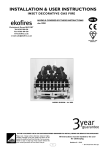
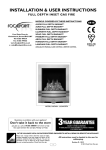
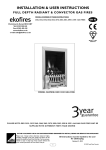
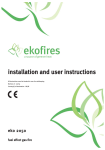

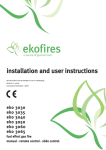
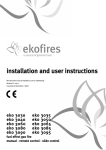
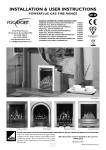
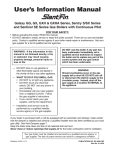

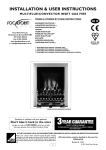
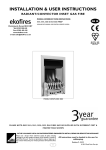
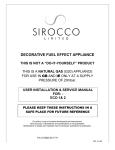
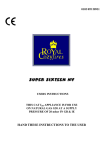
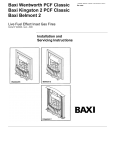
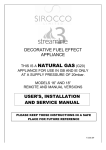
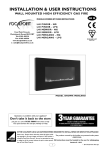
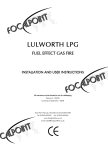

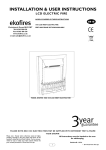
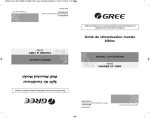
![Eko 2030 Installation instructions [EN] A:XL09 Installation](http://vs1.manualzilla.com/store/data/005791571_1-4177cf65afac91638228769661e5ee6f-150x150.png)